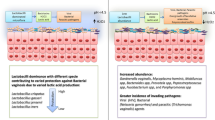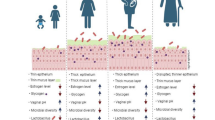Abstract
Objectives
To answer the questions: (1) Does reducing estrogen levels influence the microbial composition of the oral cavity? (2) Does the presence of periapical lesion (PL) cause changes in the oral microbiota? (3) Since estrogen deficiency alters the oral microbiota, can this be one of the factors that contribute to the increase of the PL?
Materials and methods
Thirty-six rats were divided into four groups: sham (control), ovariectomy (OVX), control with PL (Sham + PL), and OVX + PL. After 9 weeks of OVX, the lower first molars were submitted to PL induction. After 21 days, the microbiological collection of the oral cavity was performed, and the animals were euthanized. The contents were evaluated by the checkerboard DNA-DNA hybridization method, to verify the prevalence of 40 bacterial species (divided into 7 microbial complexes). The blocks containing the lower first molars were submitted to histotechnical processing and staining with hematoxylin and eosin (HE), for the measurement of the periapical lesion area. The results were submitted to ANOVA and Kruskal-Wallis tests and Tukey and Dunn post-tests, with a significance level of 5%.
Results
In conditions of estrogen deficiency, there was alteration of the oral microbiota. The OVX groups had a higher amount of bacteria compared to the SHAM group in most of the microbial complexes (p < 0.001). The animals in the control group (with or without lesion) did not present a statistically significant difference (p > 0.001) in any of the microbial complexes. The PLs in OVX animals were significantly higher compared to SHAM animals (p < 0.001).
Conclusions
Hypoestrogenicity conditions interfere in the oral microbiota by increasing the amount of bacteria in the saliva and influencing the progression of periapical lesions.
Clinical relevance
This inedited study shows that deficiency of estrogen leads to alteration of the oral microbiota.




Similar content being viewed by others
References
Chen KL, Madak-Erdogan Z (2016) Estrogen and microbiota crosstalk: should we pay attention? Trends Endocrinol Metab 27:752–755
Mauvais-Jarvis F, Clegg DJ, Hevener AL (2013) The role of estrogens in control of energy balance and glucose homeostasis. Endocr Rev 34:309–338
Mattsson C, Olsson T (2007) Estrogens and glucocorticoid hormones in adipose tissue metabolism. Curr Med Chem 14:2918–2924
Cao M, Shu L, Li J, Su J, Zhang W, Wang Q, Guo T, Ding Y (2007) The expression of estrogen receptors and the effects of estrogen on human periodontal ligament cells. Methods Find Exp Clin Pharmacol 29:329–335
Minicucci EM, Pires RB, Vieira RA, Miot HA, Sposto MR (2013) Assessing the impact of menopause on salivary flow and xerostomia. Aust Dent J 58:230–234
Hernández-Vigueras S, Martinez-Garriga B, Sanchez MC, Sanz M, Estrugo-Devesa A, Vinuesa T, López-López J, Viñas M (2015) Oral microbiota, periodontal status, and osteoporosis in postmenopausal females. J Periodontol 87:124–133
Riggs BL, Khosla S, Melton LJ 3rd (1998) A unitary model for involutional osteoporosis: estrogen deficiency causes both type I and type II osteoporosis in postmenopausal women and contributes to bone loss in aging men. J Bone Miner Res 13:763–773
Almeida M, Laurent MR, Dubois V, Claessens F, O'Brien CA, Bouillon R, Vanderschueren D, Manolagas SC (2017) Estrogens and androgens in skeletal physiology and pathophysiology. Physiol Rev 97:135–187
Emerton KB, Hu B, Woo AA, Sinofsky A, Hernandez C, Majeska RJ, Jepsen KJ, Schaffler MB (2010) Osteocyte apoptosis and control of bone resorption following ovariectomy in mice. Bone 46:577–583
Vieira AT, Castelo PM, Ribeiro DA, Ferreira CM (2017) Influence of oral and gut microbiota in the health of menopausal women. Front Microbiol 8:1–7
Liang L, Yu JF, Wang Y, Wang G, Ding Y (2008) Effect of estrogen receptor beta on the osteoblastic differentiation function of human periodontal ligament cells. Arch Oral Biol 53:553–557
Martínez-Maestre MÁ, González-Cejudo C, Machuca G, Torrejón R, Castelo-Branco C (2010) Periodontitis and osteoporosis: a systematic review. Climacteric 13:523–529
Weitzmann MN, Pacifici R (2006) Estrogen deficiency and bone loss: an inflammatory tale. J Clin Invest 116:1186–1194
Romualdo PC, Lucisano MP, Paula-Silva FWG, Leoni GB, Sousa-Neto MD, Silva RAB, Silva LAB, Nelson-Filho P (2018) Ovariectomy exacerbates apical periodontitis in rats with increase in expression of proinflammatory cytokines and matrix metalloproteinases. J Endod 44:789–785
Youssef H, Stashenko P (2017) Interleukin-1 and estrogen protect against disseminating dentoalveolar infections. Int J Oral Sci 9:16–23
Nasidze I, Li J, Quinque D, Tang K, Stoneking M (2009) Global diversity in the human salivary microbiome. Genome Res 19:636–643
Belstrom D, Holmstrup P, Fiehn N-E, Rosing K, Bardow A, Paster BJ, Pedersen AML (2016) Bacterial composition in whole saliva from patients with severe hyposalivation- a case control study. Oral Dis 22:330–337
Pereira IF, Brasileiro CB, Kleperon NP, Abreu MHNG, Silva TAD, Mesquita RA, Amaral TMP (2018) Comparative study of oral and salivary parameters in patients with and without loss of bone mass. Braz Oral Res 32:e54
Park MS, Chung JW, Kim YK, Chung SC, Kho HS (2007) Viscosity and wettability of animal mucin solutions and human saliva. Oral Dis 13(2):181–186
Sewón LA, Karjalainen SM, Söderling E, Lapinleimu H, Simell O (1998) Associations between salivary calcium and oral health. J Clin Periodontol 25(11):915–919
Silva RAB, Sousa-Pereira AP, Lucisano MP, Romualdo PC, Paula-Silva FWG, Consolaro A, Silva LAB, Nelson-Filho P (2020) Alendronate inhibits osteocyte apoptosis and inflammation via IL-6, inhibiting bone resorption in periapical lesions of ovariectomized rats. Int Endod J 53:84–96
Orrico SR, Gonçalves D, Galeazzi ST, Giro G, Takayama L, Pereira RM (2005) The influence of loss of bone mass on induced periodontal disease: a radiographic and densitometric study of female rats. J Periodont 76:1436–1442
Kawashima N, Stashenko P (1999) Expression of bone-resorptive and regulatory cytokines in murine periapical inflammation. Arch Oral Biol 44:55–66
de Oliveira KMH, da Silva RAB, De Rossi A, Fukada SY, Feres M, Nelson-Filho P, da Silva LAB (2015) Absence of interleukin 22 affects the oral microbiota and the progression of induced periapical lesions in murine teeth. Int Endod J 48:46–59
Nascimento C, Barbosa RES, Issa JPM, Watanabe E, Ito IY, de Albuquerque Junior RF (2009) Use of checkerboard DNA-DNA hybridization to evaluate the internal contamination of dental implants and comparison of bacterial leakage with cast or pre-machined abutments. Clin Oral Implants Res 20:571–577
Nascimento C, de Albuquerque RF, Monesi N, Candido-Silva JÁ (2010) Alternative method for direct DNA probe labeling and detection using the checkerboard hybridization format. J Clin Microbiol 48:3039–3040
Haffajee AD, Socransky SS, Patel MR, Song X (2008) Microbial complexes in supragingival plaque. Oral Microbiol Immunol 23:196–205
Bergamo AZN, Nelson-Filho P, Andrucioli MCD, do Nascimento C, Pedrazzi V, Matsumoto MAN (2017) Microbial complexes levels in conventional and self-ligating brackets. Clin Oral Investig 21:1037–1046
Andrucioli MCD, Nelson-Filho PN, Matsumoto MAN, Saraiva MCP, Feres M, Figueiredo LC, Martins LP (2012) Molecular detection of in-vivo microbial contamination of metallic orthodontic brackets by checkerboard DNA-DNA hybridization. Am J Orthod Dentofacial Orthop 141:24–29
De Rossi A, Rocha LB, Rossi MA (2007) Application of fluorescence microscopy on hematoxylin and eosin-stained sections of healthy and diseased teeth and supporting structures. J Oral Pathol Med 36:377–381
Ruviere DB, Leonardo MR, da Silva LA, Ito IY, Nelson-Filho P (2007) Assessment of the microbiota in root canals of human primary teeth by checkerboard DNA-DNA hybridization. J Dent Child 74:118–123
Nelson-Filho P, Olmedo LY, Andrucioli MC, Saraiva Mda C, Matsumoto MA, de Queiroz AM, da Silva RA, da Silva LA (2011) Use of the checkerboard DNA-DNA hybridisation technique for in vivo detection of cariogenic microorganisms on metallic brackets, with or without use of an antimicrobial agent. J Dent 39:513–517
Nelson-Filho P, Carpio-Horta KO, Andrucioli MCD, Feres M, Silva RAB, Paula-Silva FWG, Romano FL (2012) Molecular detection of aggregatibacter actinomycetemcomitans on metallic brackets by checkerboard DNA-DNA hybridization technique. Am J Orthod Dentofacial Orthop 142:481–486
Socransky SS. Haffajee AD (1998) Cugini MA, Smith C, Kent Jr. RL: Microbial complexes in subgingival plaque. J Clin Periodontol 25: 134-144.
Kalu DN (1991) The ovariectomized rat model of postmenopausal bone loss. Bone Miner 15:175–191
Thompson DD, Simmons HA, Pirie CM, Ke HZ (1995) FDA Guidelines and animal models for osteoporosis. Bone 17:125S–133S
Jenkinson HF, Lamont RJ (2005) Oral microbial communities in sickness and in health. Trends Microbiol 13:589–595
Liu B, Faller LL, Klitgord N, Mazumdar V, Ghodsi M, Sommer DD, Gibbons TR, Treangen TJ, Chang YC, Li S, Stine OC, Hasturk H, Kasif S, Segrè D, Pop M, Amar S (2012) Deep sequencing of the oral microbiome reveals signatures of periodontal disease. PLoS One 7:37919
Almståhl A, Carlén A, Eliasson L, Lingström P (2010) Lactobacillus species in supragingival plaque in subjects with hyposalivation. Arch Oral Biol 55:255–259
Brennan RM, Genco RJ, Wilding GE, Hovey KM, Trevisan M, Wactawski-Wende J (2007) Bacterial species in subgingival plaque and oral bone loss in postmenopausal women. J Periodontol 78:1051–1061
Xiong H, Peng B, Wei L, Zhang X, Wang L (2007) Effect of an estrogen-deficient state and alendronate therapy on bone loss resulting from experimental periapical lesions in rats. J Endod 33:1304–1308
Gomes-Filho JE, Wayama MT, Dornelles RC, Ervolino E, Yamanari GH, Lodi CS, Sivieri-Araújo G, Dezan-Júnior E, Cintra LT (2015) Raloxifene modulates regulators of osteoclastogenesis and angiogenesis in an oestrogen deficiency periapical lesion model. Int Endod J 48:1059–1068
Brasil SC, Santos MM, Fernandes A, Alves FRF, Pires FR, Siqueira JF Jr, Armada L (2017) Influence of estrogen deficiency on the development of apical periodontitis. Int Endod J 50:161–166
López-López J, Castellanos-Cosano L, Estrugo-Devesa A, Gómez-Vaquero C, Velasco-Ortega E, Segura-Egea JJ (2013) Radiolucent periapical lesions and bone mineral density in post-menopausal women. Gerodontology 32:195–201
López-López J, Castellanos-Cosano L, Estrugo-Devesa A, Gómez-Vaquero C, Velasco-Ortega E, Segura-Egea JJ (2015) Radiolucent periapical lesions and bone mineral density in post-menopausal women. Gerodontology 32:195–201
Gilles JA, Carnes DL, Dallas MR, Holt SC, Bonewald LF (1997) Oral bone loss is increased in ovariectomized rats. J Endod 23:419–422
Liu S, Cheng Y, Xu W, Bian Z (2010) Protective effects of follicle-stimulating hormone inhibitor on alveolar bone loss resulting from experimental periapical lesions in ovariectomized rats. J Endod 36:658–663
Mahesh DR, Komali G, Jayanthi K, Dinesh D, Saikavitha TV, Dinesh P (2014) Evaluation of salivary flow rate, pH and buffer in pre, post & post menopausal women on HRT. J Clin Diagn Res 8:233–236
Eliasson L, Carlén A, Laine M, Birkhed D (2003) Minor gland and whole saliva in postmenopausal women using a low potency oestrogen (oestriol). Arch Oral Biol 48:511–517
Yalcin F, Gurgan S, Gurgan T (2005) The effect of menopause, hormone replacement therapy (HRT), alendronate (ALN), and calcium supplements on saliva. J Contemp Dent Pract 6:10–17
Valimaa H, Savolainen S, Soukka T, Silvoniemi P, Makela S, Kujari H, Gustafsson JA, Laine M (2004) Estrogen receptor-beta is the predominant estrogen receptor subtype in human oral epithelium and salivary glands. J Endocrinol 180:55–62
Kovats S (2015) Estrogen receptors regulate innate immune cells and signaling pathways. Cell Immunol 294:63–69
Funding
The work was supported by the São Paulo Research Foundation (FAPESP) (grant nos. 2013/18231-9 and 2014/13238-8).
Author information
Authors and Affiliations
Corresponding author
Ethics declarations
Conflict of interest
The authors declare that they have no conflict of interest.
Ethical approval
All applicable international, national, and/or institutional guidelines for the care and use of animals were followed.
Informed consent
For this type of study, formal consent is not required.
Additional information
Publisher’s note
Springer Nature remains neutral with regard to jurisdictional claims in published maps and institutional affiliations.
Supplementary Information
ESM 1
(PDF 5364 kb)
Rights and permissions
About this article
Cite this article
Lucisano, M.P., da Silva, R.A.B., de Sousa Pereira, A.P. et al. Alteration of the oral microbiota may be a responsible factor, along with estrogen deficiency, by the development of larger periapical lesions. Clin Oral Invest 25, 3651–3662 (2021). https://doi.org/10.1007/s00784-020-03688-5
Received:
Accepted:
Published:
Issue Date:
DOI: https://doi.org/10.1007/s00784-020-03688-5




